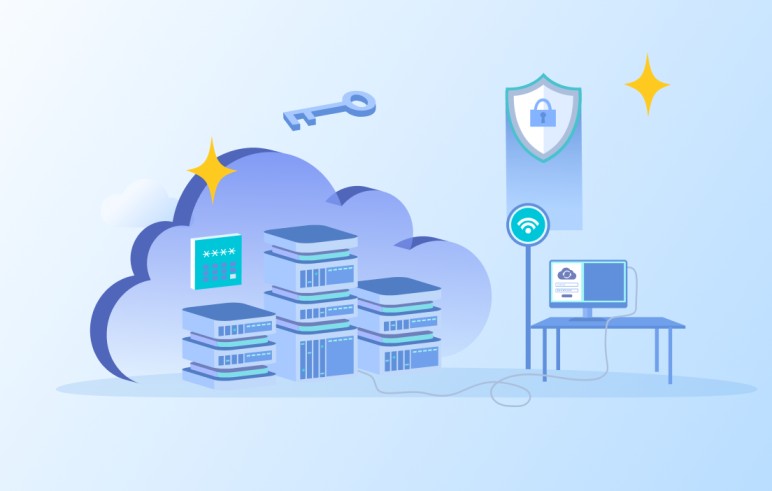The contemporary rise in cloud adoption has created new challenges for security measures. Managed security services providers are leaving no stone unturned, collaborating with security solution vendors to develop advanced products that meet their clients' evolving security needs.
The growth of the global cloud security software market reflects this, reaching a value of 29.5 billion U.S. dollars in 2020. A report by Statista projects that the global market for cloud security software will get around 37 billion U.S. dollars by 2026.
While North America is currently the cream of the crop, the Asia Pacific region is coming up with roses with the highest growth rate. Knowing the potential risks is crucial if you store your data on cloud platforms. Despite the many benefits of cloud storage, the security of data stored online is not a bed of roses.
With the increasing amount of information held in the cloud, security has become a top concern for businesses and individuals. Don't leave the safety of your valuable data to chance - nip it in the bud and protect it. As companies migrate their workloads to the cloud, security concerns such as data loss, confidentiality, or accidental exposure of credentials have become more critical than ever.
Over the past years, cyber threats have increased in numbers and variety, making security solutions essential to ensuring business continuity. A recent survey revealed that 80% of companies have encountered at least one cloud security incident in the past year.
In comparison, 27% have experienced an incident related explicitly to public cloud security - a 10% increase from the previous year. Hackers are constantly finding new ways to breach even the most secure systems, making it essential to stay one step ahead by fortifying the cloud with next-level security measures.
In this blog post, we'll explore the current state of cloud security and discuss advanced security measures that can help protect against hacking attempts.
1. Understanding Cloud Security Challenges and Threats
Recently, Forbes let the cat out of the bag that many individuals feel they need a thorough understanding of cloud security and its essential components. A survey revealed that 79% of respondents reported their CISOs and cybersecurity leaders are feeling the heat to improve their cloud-related skills.
The growth of cloud computing has thrown a spanner in the works, introducing several challenges that aren't always adequately planned or managed. Cloud service providers like Amazon Web Services, Microsoft Azure, and Google Cloud have adopted the Shared Responsibility Model, taking on the security responsibility of physical I.T. infrastructure.
Cloud security challenges
According to a survey by Forbes, the top 12 cloud security challenges faced by organizations are like walking a tightrope:
- Identifying workload configurations that are out of compliance with industry best practices and regulatory frameworks (39%).
- Identifying software vulnerabilities (32%).
- Maintaining an audit trail of privileged user and service account activity (29%).
- Configuring security groups for externally facing server workloads (28%).
- Monitoring operating system level activity, such as processes and file system changes (25%).
- Detecting malware (23%).
- Managing the location and disposition of secrets, such as passwords, API keys, and admin credentials (23%).
- Maintaining an up-to-date inventory of cloud-based assets (22%).
- Managing the permissions associated with service accounts (21%).
- Monitoring APIs and serverless function activity (19%).
- Monitoring lateral server and container workload communication, or "east-west traffic" (15%).
- Detecting anomalous activity (13%).

Cloud security threats
Businesses must deal with several cloud security threats, including advanced persistent threats, zero-day exploits, insider threats, and cyberattacks. These threats can result in opening a can of worms:
These threats can result in:
- Data breaches
- Lack of cloud security architecture
- Insecure APIs
- DDoS attacks
- Hijacking of accounts
- Limited cloud visibility
- Malware attacks
- Metastructure failures
- Misconfiguration
- Account takeover
- Insider risks
- Weak access controls
- Regulatory compliance issues
Organizations must bite the bullet to improve cloud security and address these challenges, understanding common threats to enhance data protection. By taking proactive measures to nip these risks in the bud, businesses can better protect their data and services in the cloud against potential security threats.
2. Advanced Security Measures for Cloud Computing
As security measures are necessary to keep the wolves at bay, the following section will explore advanced security measures that organizations can implement to address challenges and threats in cloud computing.
Multi-factor authentication
- Simple yet effective: MFA is a no-brainer way to enhance the security of your information and protect against data breaches.
- Multiple methods: MFA doubles down on security by using various techniques to verify your identity, such as receiving a code on your phone or using single-use passwords.
- Safeguarding against threats: While it may take some extra time, MFA is crucial in protecting against cloud security threats.
Use strong passwords
- Crucial: Using strong passwords is paramount for enhancing the security of your information.
- Password management service: We recommend using a password management service like LastPass to store and manage your passwords. This allows you to create complex passwords without remembering and securely sharing them across your company.
- Maximum security: For ultimate peace of mind, it's also important to regularly change your passwords.
Manage permissions sharing
- Track who has access: To lock down cloud security, managing permissions sharing is essential. This involves keeping tabs on who has access to what information and updating permissions when necessary.
- Educate employees: Train employees not to share their account details and carefully manage permissions to prevent unauthorized access to sensitive data.
- User Entitlement Review: Regular user entitlement reviews are also essential to ensure that only authorized personnel can access sensitive data and that permissions are up to snuff.
Ensure encryption
- Crucial: Encrypting data transferred between your company and the cloud is vital for enhancing security.
- Virtual private network (VPN): One way to do this is by using a virtual private network (VPN), which provides a standard level of encryption for all users.
- Private connections: VPNs are personal connections inaccessible to anyone outside the network, making them ideal for remote work.
- Third-party encryption tools: Users can use several third-party encryption tools to encrypt files before uploading them to the cloud, ensuring that data is encrypted in transit and at rest.
Install anti-virus software
- Vulnerabilities: Sometimes, security breaches can occur due to cracks in the armor on the systems used to access the cloud.
- Protect against hackers: To guard against hackers and malicious software, ensuring that anti-virus protection is up to snuff on all devices used to access the cloud is vital.
- Remote workers: This is especially important for remote employees who use their hardware.
- Policy in place: Make sure to have a policy in place to ensure that all devices are adequately protected.
Backup your data
- One of the most important: Backing up your data is one of the most critical cloud computing security measures you can take. It's like having a fire extinguisher in the kitchen – you hope you never need it, but it's there just in case.
- Contingency plan: A contingency plan is crucial in case of data loss or corruption. This could mean having a local backup, using another cloud service, or both.
- Local backup: You can choose a local backup stored on your device. This is a good option if you need to access your data quickly.
- Multiple backups: Having multiple data backups is always a good idea. If one backup is lost or corrupted, you still have others to fall back on.
Test your security

- Effective way: Testing your cloud security is an effective way to ensure its safety. It's like taking your car to the mechanic for a tune-up – you want to ensure everything works properly.
- Ethical hackers: Large organizations with sensitive information on the cloud can hire ethical hackers to assess their security. These security experts will try to hack into your systems to find vulnerabilities.
- Vulnerability testing: Your cloud provider should also offer vulnerability testing, an ongoing process to keep your security up-to-date.
By following these tips, you can help to protect your organization from cloud security threats.
3. Companies That Have Successfully Implemented Cloud Computing
Cloud computing has revolutionized companies' operations, increasing flexibility, scalability, and cost savings. In this section, we'll look at some companies successfully implementing cloud computing and their reaped benefits.
Apple (Cloud provider: iCloud, AWS and Google Cloud)

Apple relies on multiple cloud service providers to support its iCloud services. A CNBC report states that Apple is one of Amazon Web Services (AWS) largest customers, with monthly payments to the cloud division exceeding an astonishing 30 million and continuing to rise. In 2016, Apple agreed with Google to utilize its cloud platform for certain iCloud services.
iCloud, developed by Apple Inc., allows users to store and sync data across devices, including Apple Mail, Apple Calendar, Apple Photos, Apple Notes, contacts, settings, backups, and files. It also enables collaboration with other users and asset tracking through Find My.
By leveraging multiple cloud service providers, Apple can ensure the reliability and security of its iCloud services for its hundreds of millions of users worldwide.
Netflix (Cloud provider: AWS)
With its critically acclaimed films, lates犀利士
t box office releases, and original series, Netflix has secured the lion's share of 53.5% of the global on-demand streaming market. The company delivers over 125 million hours of daily entertainment to hundreds of millions of users worldwide, using AWS as its cloud provider.
AWS supplies Netflix with the essential infrastructure and computing capabilities for rapid scaling and ongoing innovation, enabling the company to provide services in more than 190 countries with content in over 30 languages.
PayPal (Cloud provider: Google Cloud)
In just the first quarter of 2021, PayPal processed over 3.74 bill transactions for its more than 300 million users worldwide. While it may appear to be a simple online payment service to an individual user, the company requires tremendous operational horsepower to handle the large volume of daily transactions while ensuring top security, managing financial risks, and preventing fraud.
This was possible after PayPal partnered with Google Cloud in 2018. Now, let's explore some best practices to improve cloud security and build trust among cloud users. By implementing these measures, businesses and organizations can better protect their sensitive data and information in the cloud, reducing the risk of cyber threats and data breaches.
4. 10 Best Steps to Improve Cloud Security
Identity and Access Management (IAM) in the Cloud
Identity and Access Management (IAM) in the Cloud is a security framework that keeps tabs on who's who and ensures they only have access to what they need to secure access to cloud resources. IAM is essential for keeping tabs on user accounts and permissions and monitoring access to cloud resources.
Proper implementation, using methods such as Role-Based Access Control (RBAC), Multi-Factor Authentication (MFA), and password management, helps keep unauthorized users out and prevent misuse of sensitive data.
Cloud infrastructure configuration standards
Cloud infrastructure configuration standards provide guidelines for securing and standardizing cloud resource configuration. Adherence to these standards can prevent vulnerabilities and reduce the risk of compromise. Tools like Chef or Puppet, or a CSPM solution can achieve the implementation for effective cloud resource management.
Continuous Cloud Security Posture Management (CSPM)
Continuous Cloud Security Posture Management (CSPM) prevents cloud breaches by continuously monitoring cloud resources for security vulnerabilities, enabling prompt identification and resolution. When integrated with managed SOC services, CSPM becomes even more effective, as security teams can detect, analyze, and respond to threats in real time. This combined approach is critical for keeping your data safe, maintaining compliance, and reducing the overall risk of compromise.
Solutions like Qualys CloudCheckr or Check Point CloudGuard can achieve CSPM or integration with a cloud infrastructure configuration management tool.
Pervasive visibility and monitoring
Pervasive visibility and monitoring involve monitoring all aspects of a cloud environment for security threats. This is like having eyes everywhere so that you can spot any potential problems early on. Implementation is crucial for early threat detection and reducing unnoticed breach risk.
Achieving this is possible through a SIEM solution like Splunk or IBM QRadar, or by integrating with a cloud infrastructure monitoring tool.
Securing the workloads
Securing workloads involves protecting cloud applications and data through security controls, encryption, and monitoring. This is like locking your front door to keep burglars out. Implementation is crucial for preventing theft or misuse. This is possible through a CSPM solution, security controls, data encryption, DLP solutions, least privilege access control, and activity monitoring.
Application, PaaS, and API security
Application, PaaS, and API security involve locking down these resources through security controls and encryption. Implementation is crucial for keeping your data safe and preventing theft or misuse. Achieving this is possible by using a CSPM solution to implement security controls on individual cloud resources.
Data awareness and protection
Data awareness and protection involve understanding the location of your data, its usage, and the measures taken to protect it. This includes classifying your data, implementing DLP measures, and encrypting your data. Implementing data awareness and protection is crucial for preventing theft or misuse of your data.
There are several ways to implement this, such as using a DLP solution or implementing data classification policies. These methods can help you effectively protect your data in the cloud.
Monitoring and detecting cloud threats
Monitoring and detecting cloud threats involves using security tools to spot any potential problems and respond to security threats in the cloud. This includes using a SIEM solution like Splunk or IBM QRadar to monitor suspicious activity and a cloud intrusion detection system (IDS) to detect malicious traffic.
Implementing monitoring and detection is crucial for preventing security breaches. There are several ways to implement monitoring and detecting cloud threats, such as using a SIEM solution to monitor for suspicious activity and using a cloud IDS to see malicious traffic.
These methods can help you effectively monitor and respond to threats in your cloud environment.
Cloud-native mindset
A cloud-native mindset involves thinking outside the box regarding I.T. This includes understanding the benefits, challenges, and best practices of cloud computing. Adopting a cloud-native mindset is crucial for getting the most out of cloud computing and using it effectively.
There are several ways to develop a cloud-native mindset, such as reading books and articles about cloud computing, attending conferences, and talking to other cloud computing professionals. These methods can help you better understand cloud computing and how to use it effectively.
Cloud Workload Protection Platform (CWPP)
A cloud workload protection platform (CWPP) is a security solution that helps keep your cloud workloads safe from malware, ransomware, and data breaches. Implementing a CWPP is crucial for preventing the compromise of your cloud workloads.
There are several ways to implement a CWPP, such as using a cloud-based CWPP solution like CrowdStrike Falcon or Palo Alto Networks Cortex XDR or integrating a CWPP solution with your cloud infrastructure management tool. These methods can help you effectively protect your cloud workloads from threats.
By implementing these practices, you can help to prevent security breaches, protect your data, and keep your cloud workloads safe.
5. Benefits of Improving Cloud Security
There are many tangible benefits to improving cloud security, including:
- Preventing data breaches: By implementing advanced security measures, businesses can keep their sensitive information under lock and key, reducing the risk of data breaches.
- Compliance with regulations: Many industries have strict rules regarding protecting sensitive data. By improving cloud security, businesses can stay on the right side of the law and avoid potential legal consequences.
- Maintaining customer trust: Customers trust businesses to keep their personal information safe. Companies can build trust and protect their reputation by improving their cloud security.
- Avoiding financial losses: Data breaches can result in significant financial losses for businesses in terms of lost revenue and potential legal consequences. Companies can minimize the risk of these losses by improving their cloud security.
- Improve operational efficiency: By implementing security automation, businesses can free up I.T. resources to focus on other tasks.
- Reduce the risk of downtime: Businesses can reduce the risk by implementing security measures that protect against DDoS attacks and other threats.
- Improve employee productivity: Businesses can boost employee morale and productivity by creating a secure and productive work environment.
The benefits of improving cloud security are clear. By securing their cloud environment, businesses can protect their sensitive data, comply with regulations, maintain customer trust, and avoid financial losses.
Conclusion
In conclusion, cloud computing presents benefits and challenges, including threats from hackers that necessitate advanced security measures. Businesses can mitigate hacking risks and protect sensitive information by implementing multi-factor authentication, strong passwords, encryption, permission management, and data backups.
Proactive measures against cloud security challenges are crucial for organizations to understand and address threats posed by hackers. Adopting a cloud-native mindset and implementing advanced security solutions like IAM, CSPM, monitoring, and CWPP can help enhance security posture.
Improving cloud security can boost customer trust, prevent data breaches, ensure compliance with regulations, and prevent financial losses from successful hacks. As such, it is a crucial aspect of any cloud computing strategy.















Leave a Reply